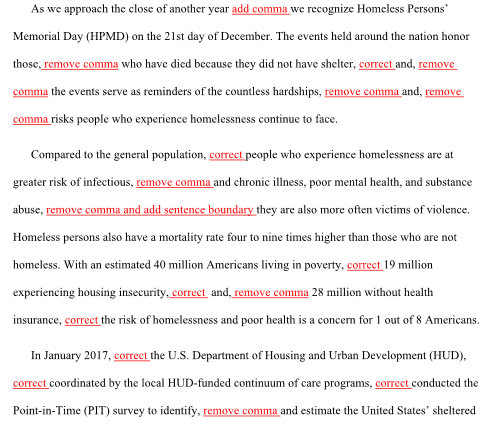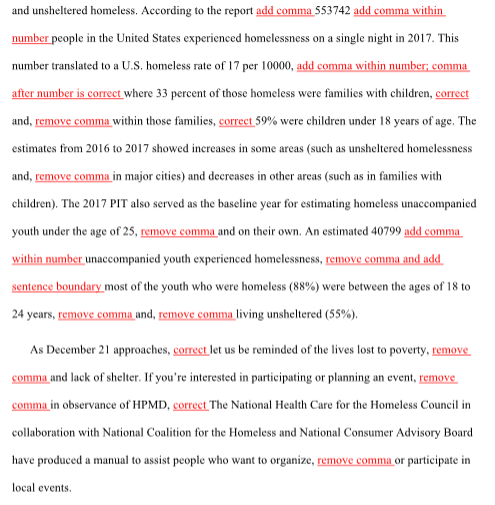The paragraphs that follow contain correctly used commas, incorrectly used commas, and missing commas. Edit the paragraphs: ? If a comma is used correctly, leave it alone. ? If a comma is used incorrectly, circle it. ? If a comma needs to be inserted, add it where it should appear.
As we approach the close of another year we recognize Homeless Persons’ Memorial Day (HPMD) on the 21st day of December. The events held around the nation honor those, who have died because they did not have shelter, and, the events serve as reminders of the countless hardships, and, risks people who experience homelessness continue to face.
Compared to the general population, people who experience homelessness are at greater risk of infectious, and chronic illness, poor mental health, and substance abuse, they are also more often victims of violence. Homeless persons also have a mortality rate four to nine times higher than those who are not homeless. With an estimated 40 million Americans living in poverty, 19 million experiencing housing insecurity, and, 28 million without health insurance, the risk of homelessness and poor health is a concern for 1 out of 8 Americans.
In January 2017, the U.S. Department of Housing and Urban Development (HUD),
coordinated by the local HUD-funded continuum of care programs, conducted the Point-in-Time (PIT) survey to identify, and estimate the United States’ sheltered and unsheltered homeless.
According to the report 553742 people in the United States experienced homelessness on a single night in 2017. This number translated to a U.S. homeless rate of 17 per 10000, where 33 percent of those homeless were families with children and, within those families, 59% were children under 18 years of age. The estimates from 2016 to 2017 showed increases in some areas (such as unsheltered homelessness and, in major cities) and decreases in other areas (such as in families
with children). The 2017 PIT also served as the baseline year for estimating homeless unaccompanied youth under the age of 25, and on their own. An estimated 40799 unaccompanied youth experienced homelessness, most of the youth who were homeless (88%) were between the ages of 18 to 24 years, and, living unsheltered (55%).
As December 21 approaches, let us be reminded of the lives lost to poverty, and lack of shelter. If you’re interested in participating or planning an event, in observance of HPMD, The National Health Care for the Homeless Council in collaboration with National Coalition for the Homeless and National Consumer Advisory Board have produced a manual to assist people who want to organize, or participate in local events.


You might also like to view...
(1) Because hikers, campers, and others who love the outdoors are likely to encounter a snake, they need to know the main differences between venomous snakes and non-venomous snakes. (2) Venomous snakes and non-venomous snakes differ in several ways. (3) Venomous snakes such as copperheads and rattlesnakes usually have triangle-shaped heads instead of the elongated oval-shaped heads of
non-venomous snakes. (5) The eyes of venomous snakes usually have elliptical-shaped pupils instead of the rounded pupils that non-venomous snakes have. (6) Venomous snakes also have fangs, which non-venomous snakes do not have. (7) A snakebite made by a venomous snake will consist of two close-set puncture marks. (8) In contrast, a non-venomous snake's bite mark will look ragged. (9) If the snake is swimming in the water, a venomous snake such as a water moccasin will swim with its entire body visible on the water's surface. (10) However, a non-venomous snake, such as a harmless water snake, will swim with only its head above water. Which of the following is a transitional expression used in the paragraph to indicate comparison or contrast? A) Because B) However C) If
Chinese and Vietnamese have moved into Lincoln Heights, but they are not displacing the
Latinos. Indicate whether the statement is true or false
Indicate what everybody is doing, using the cues provided and the present progressive.
Yo / un libro
Complete each sentence with the imperfect tense.
(Ser) las 5:00 de la tarde cuando salimos de trabajo.